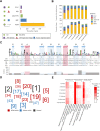Identification and expression analyses of B3 genes reveal lineage-specific evolution and potential roles of REM genes in pepper
- PMID: 38500065
- PMCID: PMC10949715
- DOI: 10.1186/s12870-024-04897-w
Identification and expression analyses of B3 genes reveal lineage-specific evolution and potential roles of REM genes in pepper
Abstract
Background: The B3 gene family, one of the largest plant-specific transcription factors, plays important roles in plant growth, seed development, and hormones. However, the B3 gene family, especially the REM subfamily, has not been systematically and functionally studied.
Results: In this study, we performed genome-wide re-annotation of B3 genes in five Solanaceae plants, Arabidopsis thaliana, and Oryza sativa, and finally predicted 1,039 B3 genes, including 231 (22.2%) newly annotated genes. We found a striking abundance of REM genes in pepper species (Capsicum annuum, Capsicum baccatum, and Capsicum chinense). Comparative motif analysis revealed that REM and other subfamilies (ABI3/VP1, ARF, RAV, and HSI) consist of different amino acids. We verified that the large number of REM genes in pepper were included in the specific subgroup (G8) through the phylogenetic analysis. Chromosome location and evolutionary analyses suggested that the G8 subgroup genes evolved mainly via a pepper-specific recent tandem duplication on chromosomes 1 and 3 after speciation between pepper and other Solanaceae. RNA-seq analyses suggested the potential functions of REM genes under salt, heat, cold, and mannitol stress conditions in pepper (C. annuum).
Conclusions: Our study provides evolutionary and functional insights into the REM gene family in pepper.
Keywords: Abiotic stress; B3; Pepper; REM; Re-annotation; Solanaceae; Transcription factors.
© 2024. The Author(s).
Conflict of interest statement
The authors declare no competing interests.
Figures





References
MeSH terms
Substances
Grants and funding
LinkOut - more resources
Full Text Sources

